fuel consumption BMW X5 4.4I 2001 Owners Manual
[x] Cancel search | Manufacturer: BMW, Model Year: 2001, Model line: X5 4.4I, Model: BMW X5 4.4I 2001Pages: 223, PDF Size: 2.66 MB
Page 19 of 223
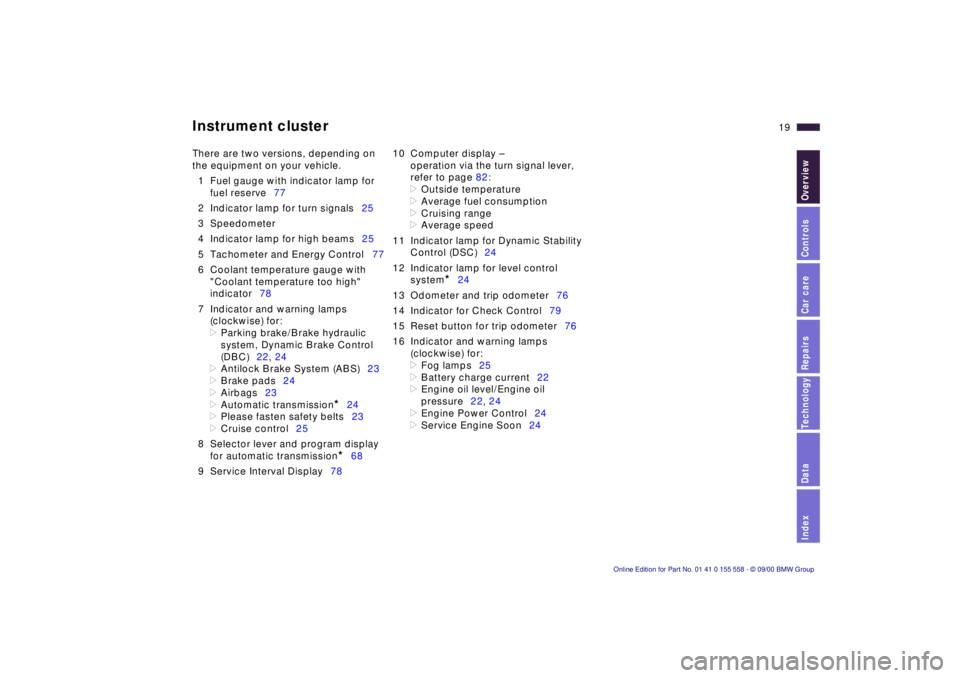
Index
Data
Technology
Repairs
Car care
Controls
Overview
19n
Instrument cluster
There are two versions, depending on
the equipment on your vehicle.
1 Fuel gauge with indicator lamp for fuel reserve 77
2 Indicator lamp for turn signals 25
3 Speedometer
4 Indicator lamp for high beams 25
5 Tachometer and Energy Control 77
6 Coolant temperature gauge with "Coolant temperature too high"
indicator 78
7 Indicator and warning lamps (clockwise) for:
>
Parking brake/Brake hydraulic
system, Dynamic Brake Control
(DBC) 22, 24
>
Antilock Brake System (ABS) 23
>
Brake pads24
>
Airbags23
>
Automatic transmission
*
24
>
Please fasten safety belts 23
>
Cruise control25
8 Selector lever and program display for automatic transmission
*
68
9 Service Interval Display 7810 Computer display –
operation via the turn signal lever,
refer to page 82:
>
Outside temperature
>
Average fuel consumption
>
Cruising range
>
Average speed
11 Indicator lamp for Dynamic Stability Control (DSC) 24
12 Indicator lamp for level control system
*
24
13 Odometer and trip odometer 76
14 Indicator for Check Control 79
15 Reset button for trip odometer 76
16 Indicator and warning lamps (clockwise) for:
>
Fog lamps 25
>
Battery charge current 22
>
Engine oil level/Engine oil
pressure22, 24
>
Engine Power Control 24
>
Service Engine Soon24
Page 77 of 223
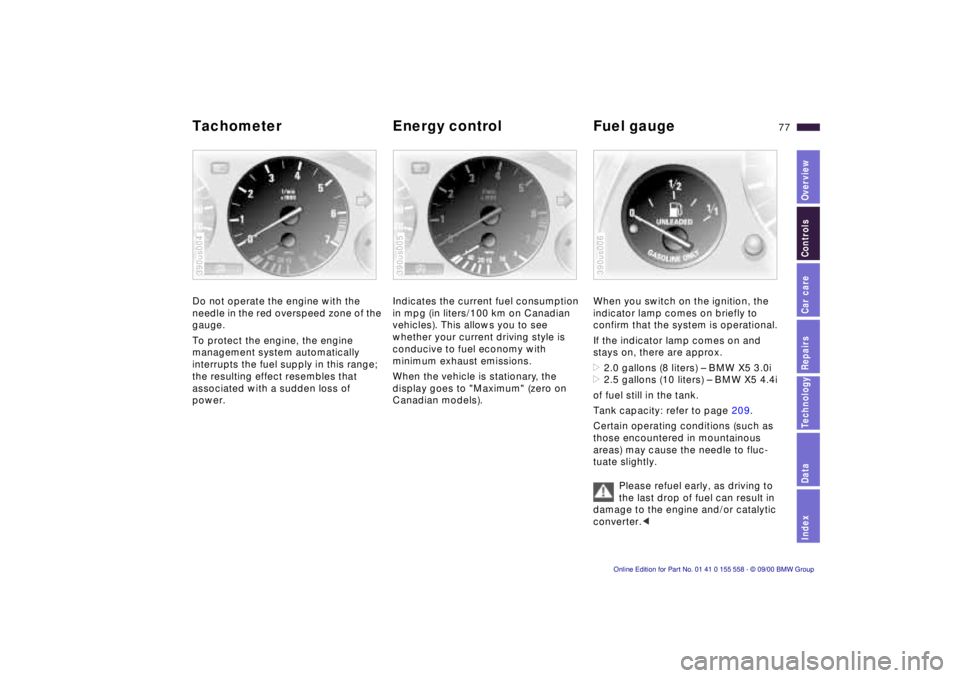
Index
Data
Technology
Repairs
Car care
Controls
Overview
77nTachometer Energy control Fuel gauge
Do not operate the engine with the
needle in the red overspeed zone of the
gauge.
To protect the engine, the engine
management system automatically
interrupts the fuel supply in this range;
the resulting effect resembles that
associated with a sudden loss of
power.
390us004
Indicates the current fuel consumption
in mpg (in liters/100 km on Canadian
vehicles). This allows you to see
whether your current driving style is
conducive to fuel economy with
minimum exhaust emissions.
When the vehicle is stationary, the
display goes to "Maximum" (zero on
Canadian models).
390us005
When you switch on the ignition, the
indicator lamp comes on briefly to
confirm that the system is operational.
If the indicator lamp comes on and
stays on, there are approx.
>2.0 gallons (8 liters) – BMW X5 3.0i
> 2.5 gallons (10 liters) – BMW X5 4.4i
of fuel still in the tank.
Tank capacity: refer to page 209.
Certain operating conditions (such as
those encountered in mountainous
areas) may cause the needle to fluc-
tuate slightly.
Please refuel early, as driving to
the last drop of fuel can result in
damage to the engine and/or catalytic
converter. <
390us006
Page 82 of 223
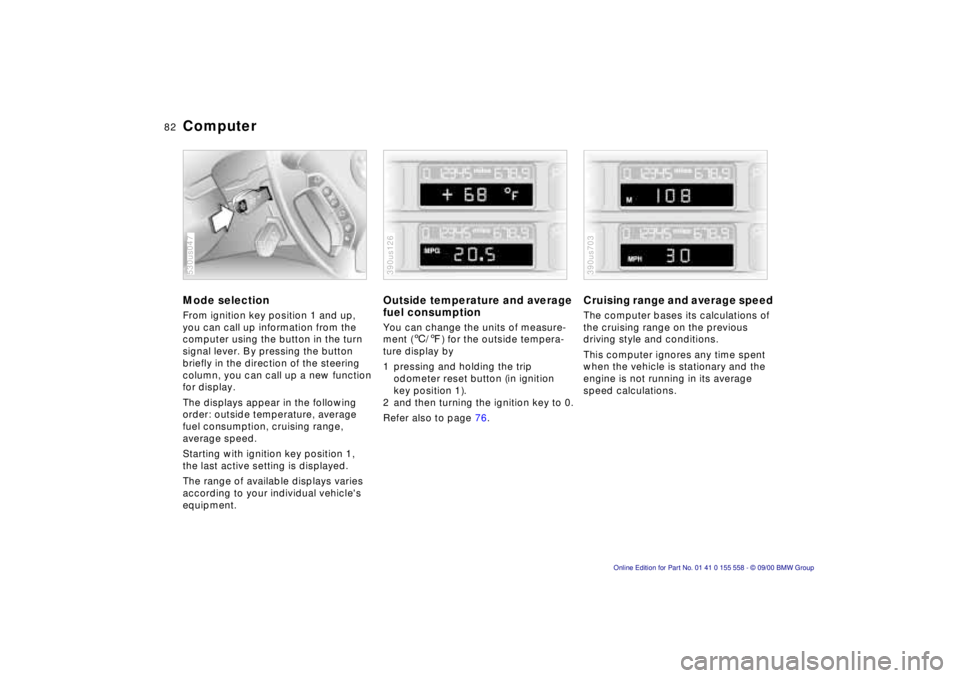
82n
Computer Mode selectionFrom ignition key position 1 and up,
you can call up information from the
computer using the button in the turn
signal lever. By pressing the button
briefly in the direction of the steering
column, you can call up a new function
for display.
The displays appear in the following
order: outside temperature, average
fuel consumption, cruising range,
average speed.
Starting with ignition key position 1,
the last active setting is displayed.
The range of available displays varies
according to your individual vehicle's
equipment.530us047
Outside temperature and average
fuel consumption You can change the units of measure-
ment (6/7) for the outside tempera-
ture display by
1 pressing and holding the trip
odometer reset button (in ignition
key position 1).
2 and then turning the ignition key to 0.
Refer also to page 76.390us126
Cruising range and average speed The computer bases its calculations of
the cruising range on the previous
driving style and conditions.
This computer ignores any time spent
when the vehicle is stationary and the
engine is not running in its average
speed calculations.390us703
Page 84 of 223
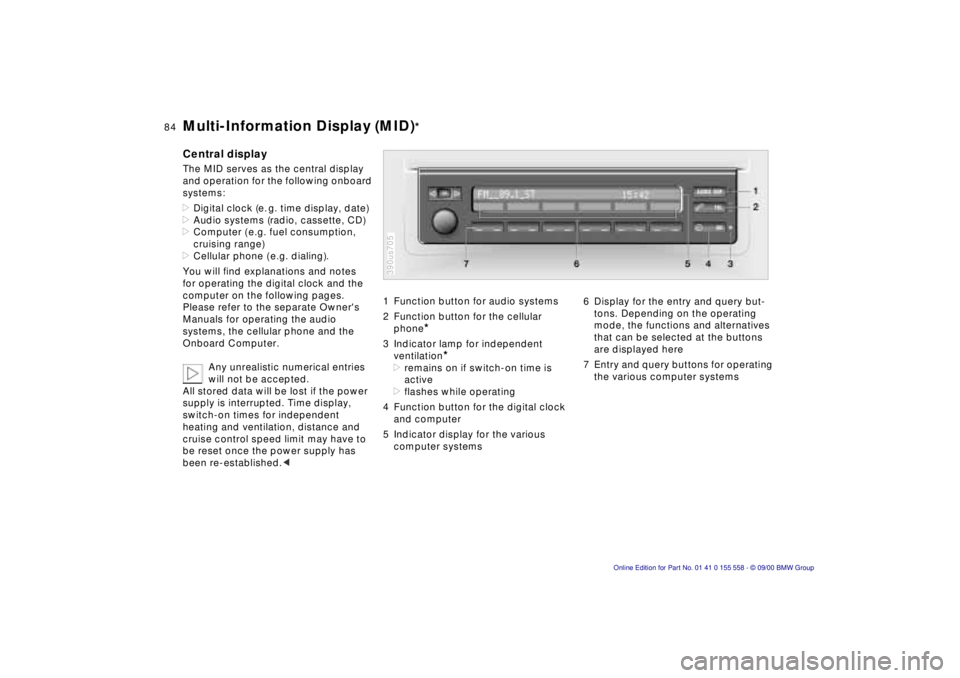
84n
Multi-Information Display (MID)
*
Central displayThe MID serves as the central display
and operation for the following onboard
systems:
>Digital clock (e. g. time display, date)
>Audio systems (radio, cassette, CD)
>Computer ( e.g. fuel consumption,
cruising range)
>Cellular phone ( e.g. dialing).
You will find explanations and notes
for operating the digital clock and the
computer on the following pages.
Please refer to the separate Owner's
Manuals for operating the audio
systems, the cellular phone and the
Onboard Computer.
Any unrealistic numerical entries
will not be accepted.
All stored data will be lost if the power
supply is interrupted. Time display,
switch-on times for independent
heating and ventilation, distance and
cruise control speed limit may have to
be reset once the power supply has
been re-established.<
1 Function button for audio systems
2 Function button for the cellular
phone
*
3 Indicator lamp for independent
ventilation
*
>remains on if switch-on time is
active
>flashes while operating
4 Function button for the digital clock
and computer
5 Indicator display for the various
computer systems390us705
6 Display for the entry and query but-
tons. Depending on the operating
mode, the functions and alternatives
that can be selected at the buttons
are displayed here
7 Entry and query buttons for operating
the various computer systems
Page 90 of 223
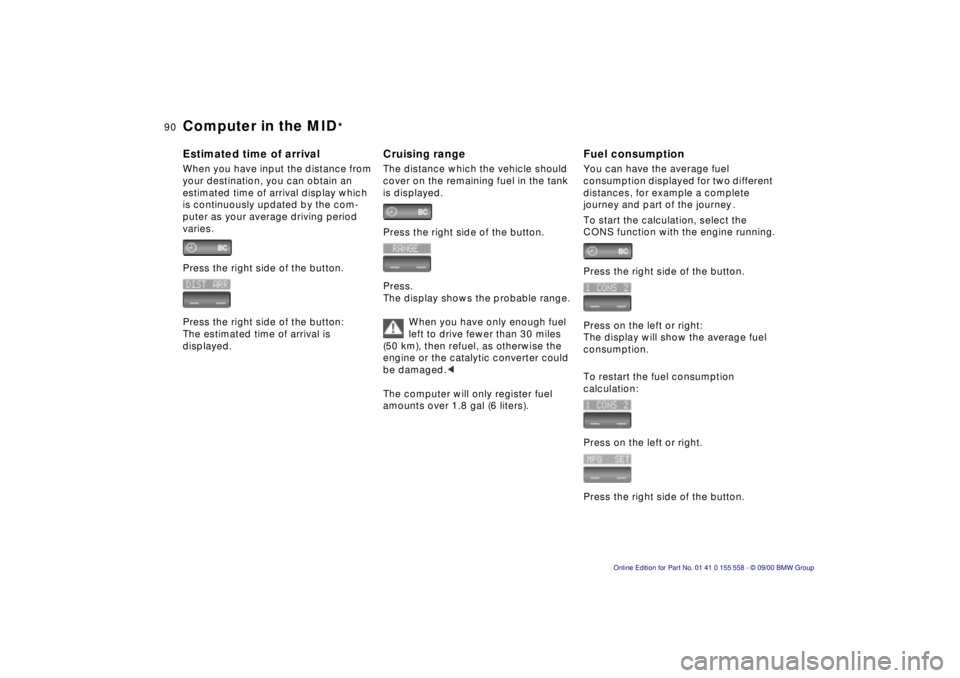
90n
Computer in the MID
*
Estimated time of arrivalWhen you have input the distance from
your destination, you can obtain an
estimated time of arrival display which
is continuously updated by the com-
puter as your average driving period
varies.
Press the right side of the button.
Press the right side of the button:
The estimated time of arrival is
displayed.
Cruising rangeThe distance which the vehicle should
cover on the remaining fuel in the tank
is displayed.
Press the right side of the button.
Press.
The display shows the probable range.
When you have only enough fuel
left to drive fewer than 30 miles
(50 km), then refuel, as otherwise the
engine or the catalytic converter could
be damaged.<
The computer will only register fuel
amounts over 1.8 gal (6 liters).
Fuel consumptionYou can have the average fuel
consumption displayed for two different
distances, for example a complete
journey and part of the journey .
To start the calculation, select the
CONS function with the engine running.
Press the right side of the button.
Press on the left or right:
The display will show the average fuel
consumption.
To restart the fuel consumption
calculation:
Press on the left or right.
Press the right side of the button.
Page 130 of 223

130n
Roof-mounted luggage rack
*
Roof-mounted luggage racks raise the
center of gravity of the vehicle when
they are loaded. For this reason, they
exercise a major effect on the vehicle's
handling and steering response.
You should therefore always remember
not to exceed the approved roof
weight, the approved gross vehicle
weight or the axle weights when
loading the rack. You will find the
specifications under "Technical Data"
on page 208.
Make sure that the load is not too
heavy, and attempt to distribute it
evenly. Always load the heaviest pieces
first (on the bottom). Be sure that
adequate clearance is maintained for
raising the sliding/tilt sunroof, and that
objects do not project into the opening
path of the liftgate. Secure the roof luggage correctly and
securely to prevent it from shifting or
being lost during driving (danger to
following traffic).
Drive smoothly. Avoid sudden accelera-
tion and braking maneuvers. Take
corners gently.
The roof load increases the aerody-
namic resistance. Increased fuel
consumption is the immediate results.
Page 157 of 223

IndexDataTechnologyRepairsCar careControlsOverview
157n
Engine oilChecking oil level1 Park the vehicle on a level surface.
2 Shut the engine off after it has
reached normal operating tempera-
ture.
3 After approx. 5 minutes, pull the
dipstick out and wipe it off with a
clean lint-free cloth, paper towel, or
similar material.
4 Push the dipstick carefully all the way
into the guide tube and pull it out
again.
5 The oil level should be in between the
two marks on the dipstick.
As with fuel economy, oil consumption
is directly influenced by your driving
style and vehicle operating conditions. 530us100
The oil volume between the two marks
on the dipstick corresponds to approx.
1.1 US quarts (1 liter). Do not fill beyond
the upper mark on the dipstick. Excess
oil will damage the engine.530us205
Adding engine oilWait until the level has dropped to just
above the lower mark before adding oil.
However, do not wait until the oil level
drops below the lower mark.
BMW engines are designed to
operate without oil additives; the
use of additives could lead to damage
in some cases. This is also true for the
manual transmission, the automatic
transmission, the differential, and the
power steering system.< 530us101
Page 214 of 223

Everything from A to Z
A
ABS (Antilock Brake System) 23, 137
Accessories 6
Activated-charcoal filter 112
Adaptive Transmission Control (ATC) 196
ADB-X (Automatic Differential Brake) 197
Adding brake fluid 161t
coolant 160t
engine oil 157t
washer fluid 156t
Adjusting head restraints 49t
mirrors 53t
seats 48t
steering wheel 52t
temperature 102 t, 108 t
washer nozzles 156t
Air conditioner 100
Air distribution 102, 108
Air outlets 100, 106
Air pressure 30t , 145 t
Air supply 102, 109
Airbags 23, 58 , 168 , 196
Alarm system 43
Antennas 144
Antifreeze 160
radiator 141 Antilock Brake System
(ABS) 23, 137
Anti-theft alarm system 43
Anti-theft protection 37
Approved gross vehicle weight 208
Aquaplaning 136, 145
Arrival time 90
Ashtray front 120
rear 121
AUC (Automatic recirculated air control) 110
Automatic car washes 163
Automatic climate control 106
removing condensation
from the windows 109
Automatic cruise control 74
Automatic curb monitor 55
Automatic Differential Brake (ADB-X) 197
Automatic dimming, interior rearview mirror 54
Automatic recirculated air
control (AUC) 110
Automatic transmission with Steptronic 68
Average fuel consumption 82
Average speed 82, 91 Avoiding unintentional
alarms 44t
Axle loads 208
B
Backup lamps 67
bulb replacement 177t
Battery 185, 210
capacity 210
charge 186t
discharged 190t
Belts 57
Beverage holder 119
Blower 102, 109
BMW comfort seat 50
BMW High Performance Synthetic Oil 158
BMW sports seat 51
BMW Universal Transmitter 115
Body-cavity protectant 164
Brake 140
fluid 161t
hydraulic system 22
malfunctions 141t
pads 24, 141
Brake system 141
bulb replacement 177t
Break-in procedures 134
Bulbs and lamps 175
C
California Proposition
65 Warning 169
Can holder, refer to cup holder 119
Capacities 209
Car jack 180
Car keys 34
Car Memory 56
Car radio reception 144, 198
Car vacuum cleaner power outlet 127t
socket 121t
Car wash 163
Care exterior 164
interior 166
Cargo area 42, 124
capacity 208
cover 124
lamps 98
opening from the
inside 41
Cargo floor, pull-out 128
Cargo loading 129
Caring for the vehicle finish 165
Catalytic converter 136
CBC (Cornering Brake Control) 138
Page 215 of 223
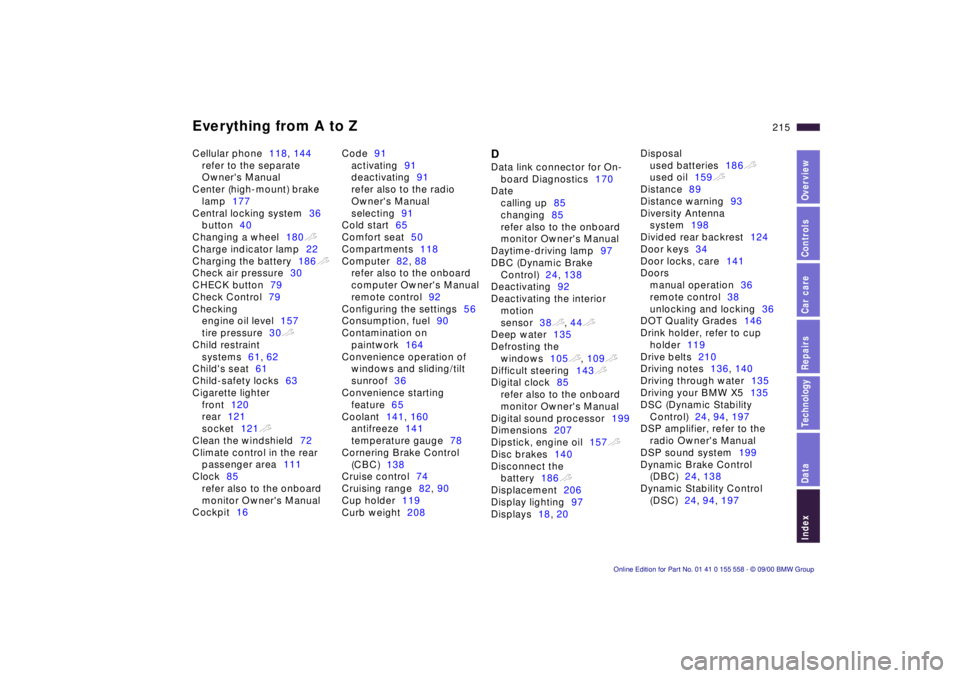
Everything from A to Z215n
Index
Data
Technology
Repairs
Car care
Controls
Overview
Cellular phone 118, 144
refer to the separate
Owner's Manual
Center (high-mount) brake lamp 177
Central locking system 36
button 40
Changing a wheel 180t
Charge indicator lamp 22
Charging the battery 186t
Check air pressure 30
CHECK button 79
Check Control 79
Checking engine oil level 157
tire pressure 30t
Child restraint systems 61, 62
Child's seat 61
Child-safety locks 63
Cigarette lighter front 120
rear 121
socket 121t
Clean the windshield 72
Climate control in the rear passenger area 111
Clock 85
refer also to the onboard
monitor Owner's Manual
Cockpit 16 Code
91
activating 91
deactivating 91
refer also to the radio
Owner's Manual
selecting 91
Cold start 65
Comfort seat 50
Compartments 118
Computer 82, 88
refer also to the onboard
computer Owner's Manual
remote control 92
Configuring the settings 56
Consumption, fuel 90
Contamination on paintwork 164
Convenience operation of windows and sliding/tilt
sunroof 36
Convenience starting feature 65
Coolant 141, 160
antifreeze 141
temperature gauge 78
Cornering Brake Control (CBC) 138
Cruise control 74
Cruising range 82, 90
Cup holder 119
Curb weight 208D
Data link connector for On-
board Diagnostics 170
Date calling up 85
changing 85
refer also to the onboard
monitor Owner's Manual
Daytime-driving lamp 97
DBC (Dynamic Brake Control) 24, 138
Deactivating 92
Deactivating the interior motion
sensor 38t , 44 t
Deep water 135
Defrosting the windows 105t, 109 t
Difficult steering 143t
Digital clock 85
refer also to the onboard
monitor Owner's Manual
Digital sound processor 199
Dimensions 207
Dipstick, engine oil 157t
Disc brakes 140
Disconnect the battery 186t
Displacement 206
Display lighting 97
Displays 18, 20 Disposal
used batteries 186t
used oil 159t
Distance 89
Distance warning 93
Diversity Antenna system 198
Divided rear backrest 124
Door keys 34
Door locks, care 141
Doors manual operation 36
remote control 38
unlocking and locking 36
DOT Quality Grades 146
Drink holder, refer to cup holder 119
Drive belts 210
Driving notes 136, 140
Driving through water 135
Driving your BMW X5 135
DSC (Dynamic Stability Control) 24, 94 , 197
DSP amplifier, refer to the radio Owner's Manual
DSP sound system 199
Dynamic Brake Control (DBC) 24, 138
Dynamic Stability Control (DSC) 24, 94 , 197
Page 216 of 223

Everything from A to Z
E
EBV (Electronic Brake Force Distribution) 138
Electric power windows 45
Electrical malfunction fuel filler door 188t
liftgate 188t
sliding/tilt sunroof 188t
tailgate 189t
Electrical system 210
Electronic Brake Force Distribution (EBV) 138
Electronic immobilizer 35
Elements of operation 16
Emergency operation doors 36t
fuel filler door 188t
liftgate 188t
sliding/tilt sunroof 188t
tailgate 189t
Energy Control 77
Engine 24
Engine compartment 152
Engine coolant 160
Engine oil 157
consumption 157
grades 158
level 24
pressure 22
Engine output 206
Engine specifications 206Error indicators
79
Estimated time of arrival 90
Exterior finish 164
Exterior mirrors 53
Exterior rearview mirrors, automatic dimming
feature 54
F
Failure messages 79t
Failure of an electrical accessory 187t
Filling the windshield washer reservoir 156t
First-aid kit 28
Fittings, tow-starting and towing 191t
Flashlight 118
Flat tire 145, 180 t
Fog lamps 98
bulb replacement 176t
Folding rear backrest 124
Footbrake 140
Footwell lamps 99
bulb replacement 178t
Four-wheel drive 197
Front area lighting 99
Front axle 200
Front fog lamps 98
Front seat adjustment 48Frost protection,
radiator 160
Fuel 30
capacity 209
display 77
gauge 77
quality 30
specifications 30
Fuel consumption 90
average 90
Fuel filler door 29
Fuses 187t
G
Garage-door opener 115
Gasoline 30
General driving notes 136
Glasses compartment 119
Glove compartment 117
bulb replacement 179t
Gross vehicle weight 208
Ground clearance 135
H
Handbrake66
Handsfree system 118
Hazard warning flashers 28
Hazard warning triangle 28
HDC (Hill Descent Control) 95
Head restraints 49Headlamp covers,
care 163t, 175 t
Headlamp flasher 70
Headlamp washer system 156
Headlamp washers 72
Heated seats 112
Heated steering wheel 113
Heating and ventilation 100, 106
Heating while stopped 110
Heating, rapid 105
Heavy cargo 129
Height 207
Height adjustment seats 48
steering wheel 52
HiFi system 199
High beams 25, 98
bulb replacement 175t
High-mount brake lamp 177
Hill Descent Control (HDC) 95
Holder for cans, refer to cup holder 119
Hood release 151t
Horn 26, 27
Hydraulic Brake Assistant refer to DBC 24, 138